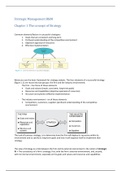Strategic Management B&M
Chapter 1 The concept of Strategy
Common elements/factors in successful strategies:
1. Goals that are consistent and long term
2. Profound understanding of the competitive environment
3. Objective appraisal of resources
4. Effective implementation
Below you see the basic framework for strategy analysis. The four elements of a successful strategy
(figure 1.1) are recast into two groups: the firm and the industry environment:
- The firm – has three of these elements
• Goals and values (simple, consistent, long-term goals)
• Resources and capabilities (objective appraisal of resources)
• Structure and systems (effective implementation.
- The industry environment – on of these elements
• Competitors, customers, suppliers (profound understanding of the competitive
environment.
The task of business strategy, is to determine how the firm will deploy its recourses within its
environment and so satisfy its long-term goals and how it will organize itself to implement that
strategy.
The view of strategy as a link between the firm and its external environment is the notion of strategic
fit = The consistency of a firm’s strategy, first, with the firm’s external environment, and, second,
with its internal environment, especially wit its goals and values and resources and capabilities.
, - Major reason for companies’ declines and failure is a strategy that lacks consistency with
either the internal of the external environment.
• Example: Italian airline, Alitalia, failed their strategy to respond to competition from
budget airlines such as Ryanair and EasyJet.
- Internal consistency among the different elements of a firm’s strategy; an effective strategy
is one in which all the decision and action that make up the strategy are aligned with one
another to crease a consistent strategic position
• This is central to Michael Porter’s conceptualization of the firm as an activity system; the
key is how these activities fit together to form a consistent, mutually reinforcing system.
See figure 1.3 (blz. 11)
- The concept of strategic fit is one component of a set of ideas known as contingency theory
= there is no single best way of organizing or managing. The best way to design, manage, and
lead an organization depend upon circumstances – in particular, the characteristics of that
organization’s environment.
During late 1960s, corporate planning (also known as long-term planning) was developed to
coordinate and maintaining control in companies; it was a five-year corporate planning that set goals
and objectives, forecasted key economic trend, established priorities for different products and
business areas, and allocated capital expenditures.
By early 1980s there was a transition from corporate planning to strategic management; it involved a
focus on competition as the central characteristic of the business environment and on performance
maximization as the primary goal of strategy.
- During 1990s, the focus of strategy analysis shifted from the sources of profit in the external
environment to the sources of profit within the firm.
- Resource-based view of the firm; identify the resources and capabilities of the firm as its
main source of competitive advantage and the primary basis for formulating strategy.
,What is strategy?
Strategy is the means by which individuals or organizations achieve their objectives. See page 15 for
different definitions:
- Common to these definitions is the notion that strategy involves setting goals, allocating
resources, and establishing consistency and coherences among decisions and actions.
- As we have seen, the conception of firm strategy has changes greatly of the past half-
century.
- As the business environment has become more unstable and unpredictable, so strategy has
become less concerned with detailed plans and more about guidelines for success. The more
turbulent the environment, the more strategy must embrace flexibility and responsiveness.
Why do firms need strategy?
Because strategy assists the effective management of organizations, first, (1) by enhancing the
quality of decision-making, second, (2) by facilitating coordination, and third, (3) by focusing
organizations on the pursuit of long-term goals.
(1) Strategy as Decision support
Strategy is a pattern of theme that gives coherence to the decisions of an individuals or organization.
Strategy improves decision-making in several ways:
- It simplifies decision-making by constraining the range of decision alternatives considered
and acting as a heuristic – a rule that reduces the search required to find an acceptable
solution to a decision problem.
- The strategy-making process permits the knowledge of different individuals to be pooled an
integrated
- It facilitated the use of analytic tools – the frameworks and techniques that we will
encounter in other chapters.
(2) Strategy as a coordinating device
The central challenge of management is coordinating the actions of multiple organizational members
Strategy acts as a communication device to promote coordination
- Statements of a strategy are a means that communicate the identity, goals, and positioning
of the company to all the members
- When the strategic planning is formulated, strategy can be translated into goals,
commitments, and performance targets that ensure that the organization moves forward in
a consistent direction.
(3) Strategy as target
Strategy is forward looking. It is not only about how the firm will compete now, but also with what
the firm will become in the future.
- Strategic intent = ‘’strategic intent created an extreme misfit between resources and
ambitions. Top management then challenges the organization to close the gap by building
new competitive advantages.’’
Where do we find strategy?
Most companies see value in communicating their strategy to employees, customers, investors, and
business partners. Collis and Rukstad identify four types of statement through which companies
communicate their strategies:
- The mission statement describes organizational purpose; Why we exist.
- A statement of principles or values outlines; ‘What we believe in and how we will behave’
- The vision statement projects; ‘what we want to be’
- The strategy statement articulated the company’s competitive game plan, which typically
describes objectives, business scope, and advantage
, Corporate and Business Strategy
Strategic choices can be made into two basic question; where to compete? And, how to compete?
The answers to these questions define the two major areas of a firm’s strategy: corporate strategy
and business strategy:
Corporate strategy
Defines the scope of the firm in terms of the industries and markets in which it competes.
- Corporate strategy decision includes choices over diversification, vertical integration,
acquisitions, and new ventures, and the allocation of resources between the different
business of the firm.
- It is the responsibilities of corporate top management
Business strategy
It is concerned with how the firm competes within a particular industry or markets.
- It must establish a competitive advantage over its rivals.
- Also referred as a competitive strategy
- Is the responsibility of the senior managers of divisions and subsidiaries
The distinction between corporate and business strategy corresponds to the primary sources of
superior profit for a firm. To survive over the long term, a firm must earn a rate of return on its
capital that exceed its cost of capital. There are two possible ways of achieving this:
1. Locating within industries that offer attractive rates of profit (corporate strategy)
- Where to compete?
2. By establishing a competitive advantage over rivals within an industry (business strategy)
- How to compete
- The where question has multiple dimension: It relates to the products the firm supplies, the
customers it serves, the countries and localities where it operates, and the vertical range of
activities it undertakes
- The how question related to the nature of the firm’s competitive advantage; Is it seeking a
cost advantage or a differentiation advantage? How is the firm using its resources and
capabilities to get a competitive advantage?
- This is especially about competing for today. However, strategy is not only about today, it is
also about ‘competing for tomorrow’.
• Future objectives relate to the overall purpose of the firm (mission), what it seeks to
become (vision), and how it will meet specific performance targets. ‘
- Two dimensions of strategy: Static (strategy as positioning) and dynamic (strategy as
Direction)







